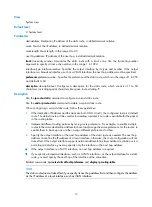
4
Table 2
Output description
Field
Description
Destination
Destination address/mask length
Protocol
Protocol that presents the route
Process ID
Process ID
Preference
Priority of the route
Cost
Cost of the route
NextHop
Address of the next hop on the route
Interface
Outbound interface for packets to be forwarded along the route
BkNextHop
Backup next hop
BkInterface Backup
outbound interface
RelyNextHop
The next hop address obtained through routing recursion
Neighbour
Neighboring address determined by Routing Protocol
Tunnel ID
Tunnel ID
Label
Label
Route status:
Active
This is an active unicast route.
Adv
This route can be advertised.
Delete
This route is deleted.
Gateway
This is an indirect route.
Holddown
Number of holddown routes. Holddown is a route advertisement
policy used in some distance vector (D-V) routing protocols, such as
RIP, to avoid the propagation of some incorrect routes. It distributes
a Holddown route during a period regardless of whether a new
route to the same destination is found. For detailed information, see
relevant routing protocols.
Int
The route was discovered by an Interior Gateway Protocol (IGP).
NoAdv
The route is not advertised when the router advertises routes based
on policies.
NotInstall
Among routes to a destination, the route with the highest priority is
installed into the core routing table and advertised. A NotInstall
route cannot be installed into the core routing table but can be
advertised.
Reject
The packets matching a Reject route will be dropped. Besides, the
router sends ICMP unreachable messages to the sources of the
dropped packets. The Reject routes are usually used for network
testing.
State
Static
A static route is not lost when you perform the save operation and
then restart the router. Routes configured manually are marked as
static
.

























